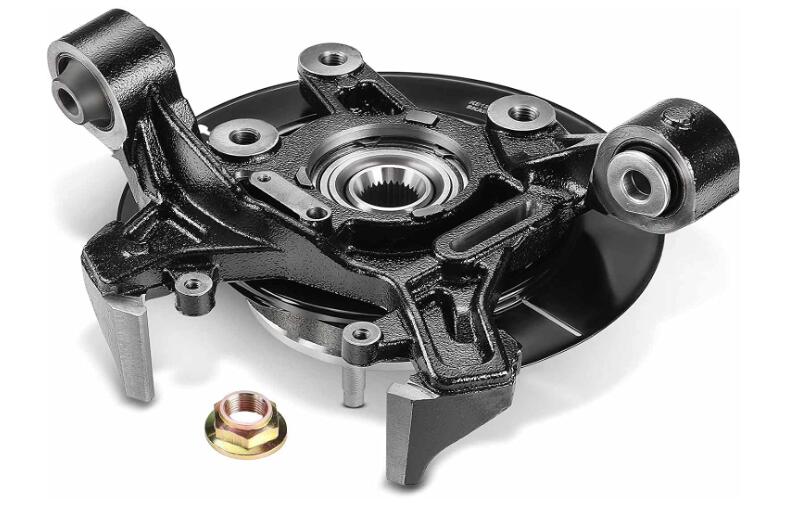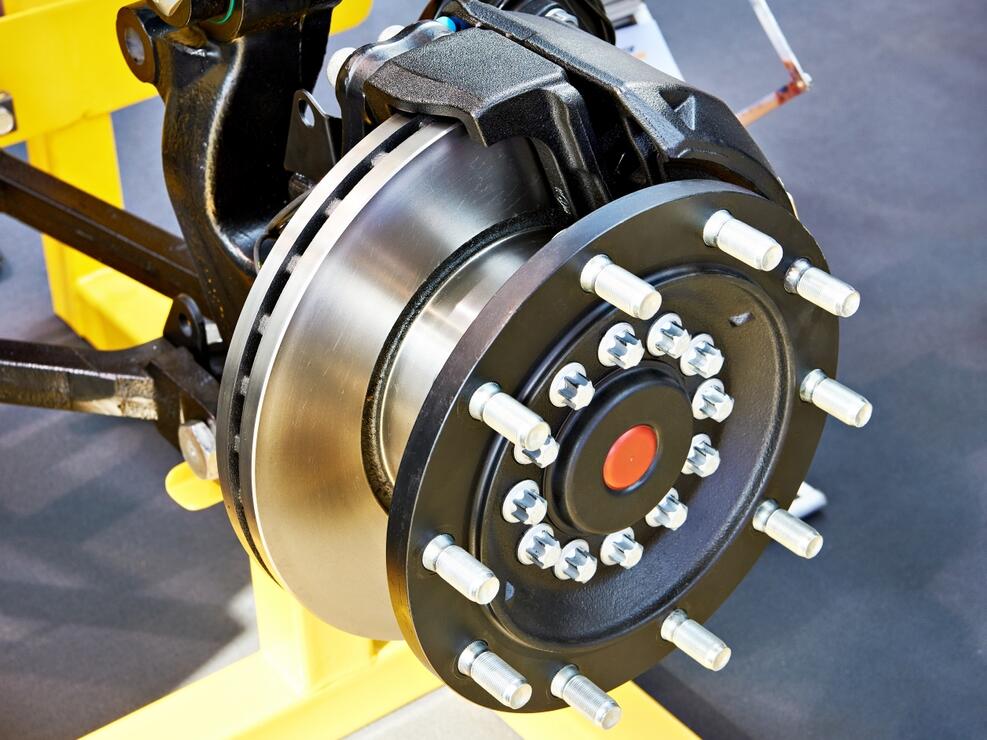Wheel hubs are essential to any vehicle’s suspension system, crucial in connecting the wheels to the car’s chassis.
The primary function of wheel hubs is to ensure smooth and efficient wheel rotation while supporting the vehicle’s weight.
This article will explore the history of wheel hubs, discuss the available types, explain the importance of proper maintenance, and provide guidance on common issues and replacement procedures.
History of Wheel Hubs
The origin of wheel hubs dates back to ancient times when they were used in horse-drawn carts and chariots.
As technology advanced and motor vehicles became more common, wheel hubs evolved to accommodate new requirements, such as improved durability, strength, and compatibility with modern braking systems.
Early automobiles used simple, non-adjustable, and non-serviceable wheel hubs, while modern vehicles now employ advanced designs with adjustable and serviceable components, ensuring longer life and better performance.
The wheel hub has evolved through 3 generations of changes.
GENERATION 1: For driven or non-driven wheels. Metal hub with a solid central spindle, spokes, and outer stationary rim.
GENERATION 2: Typically used on non-driven wheels (but there are some driven applications). Hubs made of aluminum alloy or magnesium alloy. Adjustable for wear and tear. Serviceable for long life.
GENERATION 3: For driven or non-driven wheels. Superior design and increased strength to accommodate heavier loads, superior braking systems, and improved durability in extreme weather
Types of Wheel Hubs
There are several types of wheel hubs, which differ primarily in terms of bearing types and materials used.
Understanding these differences can help you choose the right wheel hub for your vehicle or identify potential issues during maintenance.
a. Bearing Types
Wheel hubs use two main types of bearings: ball bearings and tapered roller bearings.
- Ball Bearings: These are the most common type of wheel hub bearing and feature multiple small steel balls that provide a smooth and low-friction contact surface between the seat and wheel. Ball bearings are typically found in smaller, lighter vehicles due to their compact size and relatively low load capacity.
- Tapered Roller Bearings: These bearings use tapered rollers instead of balls and are designed to handle both radial and axial loads. They are more durable.
- and capable of supporting heavier loads than ball bearings, making them suitable for larger vehicles and trucks. Tapered roller bearings are also more resistant to impact and shock loads, providing better performance under challenging conditions.
b. Materials
Wheel hubs are typically made from cast iron, steel, or aluminum. Each material has its advantages and disadvantages:
- Cast Iron: This heavy material provides excellent strength and durability, making it ideal for heavy-duty applications. However, it is also rust-prone and can be brittle under extreme stress.
- Steel: Steel wheel hubs are solid and long-lasting, offering great resistance to wear and tear. They are heavier than aluminum hubs but lighter than cast iron hubs. Steel hubs are commonly used in various vehicles, from passenger cars to commercial trucks.
- Aluminum: Aluminum wheel hubs are lightweight and offer good corrosion resistance, making them suitable for high-performance or luxury vehicles. Although they may not be as strong as steel or cast iron hubs, aluminum hubs provide better heat dissipation, which can help extend the life of wheel bearings and other components. Additionally, aluminum wheel hubs contribute to better fuel efficiency and improved handling due to reduced weight.
Importance of Proper Wheel Hub Maintenance
Regular maintenance of wheel hubs is crucial for ensuring your vehicle’s safety, performance, and longevity.
Properly functioning wheel hubs enable smooth and efficient wheel rotation, minimize vibrations, and help maintain optimal alignment.
Neglecting wheel hub maintenance can lead to premature wear, reduced fuel efficiency, uneven tire wear, and even catastrophic failure in extreme cases.
It is, therefore, important to regularly check for signs of wear and tear and replace worn or damaged parts as soon as possible.
Your vehicle’s wheel hub assembly consists of a number of components, including bearings, seals, and hubs. To ensure the best performance from your wheel hubs, keeping them properly lubricated with a high-quality lubricant is important.
In addition, if any components become worn or damaged, they should be replaced as soon as possible to prevent further damage and ensure optimal performance.
Common Problems and Solutions
Some common issues with wheel hubs include:
- Worn or damaged bearings: Symptoms may include excessive play in the wheel, abnormal noise, or uneven tire wear. Replacing the bearings can resolve these issues.
- Corrosion: Rust and corrosion can compromise the integrity of wheel hubs and lead to failure. Regular cleaning and applying anti-corrosion treatments can help prevent this problem.
- Damaged or warped hub: Physical damage or warping can cause alignment issues and vibrations. In such cases, replacing the damaged hub is necessary.
Step-by-Step Guide for Wheel Hub Replacement
Here’s a general step-by-step guide for replacing a wheel hub. The exact procedure may vary depending on your vehicle’s make and model, so consult your owner’s manual or a professional mechanic for specific instructions.
- Park your vehicle on a level surface and engage the parking brake. Place wheel chocks behind the wheels to prevent rolling.
- Loosen the lug nuts on the affected wheel before lifting the vehicle with a jack. Use jack stands to secure the car in the raised position.
- Remove the lug nuts and wheel, exposing the brake assembly and wheel hub.
- Remove the brake caliper and rotor, taking care not to damage the brake line.
- Locate the wheel hub assembly and remove any retaining bolts, clips, or nuts.
- Detach the wheel hub assembly from the vehicle by gently tapping it with a rubber mallet or using a hub puller tool, if necessary.
- Clean the mounting surface on the steering knuckle, removing any rust or debris.
- Install the new wheel hub assembly, ensuring it is properly aligned and seated.
- Reattach the retaining bolts, clips, or nuts, and tighten them to the manufacturer’s specifications.
- Reinstall the brake rotor and caliper.
- Mount the wheel and hand-tighten the lug nuts.
- Lower the vehicle to the ground and fully tighten the lug nuts in a star pattern.
- Test drive your vehicle to ensure the new wheel hub is functioning correctly and without noise or vibrations.
Wheel Hubs in Different Types of Vehicles
Cars, trucks, motorcycles, and bicycles rely on wheel hubs to keep their wheels connected to the chassis and facilitate smooth rotation. However, the design and requirements of wheel hubs may vary depending on the vehicle type:
- Cars and Trucks: These vehicles use wheel hubs to support heavier loads and often feature advanced bearing systems for improved durability and performance.
- Motorcycles: Motorcycle wheel hubs are smaller and lighter than car wheel hubs. They are specifically designed to accommodate the unique stresses and forces that motorcycles experience during cornering and maneuvering.
- Bicycles: Bicycle wheel hubs are lightweight and simpler in design. They often use sealed bearings for low maintenance and smooth performance.
Wheel Hubs and Suspension Components
Wheel hubs are integral to a vehicle’s suspension system, working closely with other components such as control arms, struts, and shock absorbers.
The proper functioning of wheel hubs is essential for maintaining optimal alignment, reducing vibrations, and ensuring a comfortable and stable ride.
Impact of Wheel Hubs on Vehicle Handling and Performance
Quality wheel hubs directly affect a vehicle’s handling, performance, and fuel efficiency. Lightweight and well-designed wheel hubs can improve acceleration and cornering, reduce unsprung weight, and provide better heat dissipation, prolonging the life of other components, such as brakes and tires.
Wheel hubs are also important for steering stability. Poorly maintained wheel hubs can cause inaccurate steering and alignment, increasing tire wear and decreased performance.
Regular maintenance of your car’s wheel hub is essential for safety and performance.
This includes checking the condition of the bearing seals and replacing them as necessary to ensure proper lubrication and protection from moisture and dirt.
Inspecting the wheel hub for signs of wear, such as scratches or grooves, is also important to ensure it continues functioning properly over time.
Comparing Wheel Hub Brands and Manufacturers
Various brands and manufacturers produce wheel hubs, each offering different quality, durability, and performance levels. Some well-known brands include SKF, Timken, Moog, and NSK. When comparing wheel hub options, consider factors such as:
- Material: The type of material used in the wheel hub affects its weight, strength, and heat dissipation.
- Bearing Type: Choose between ball bearings or tapered roller bearings based on your vehicle’s requirements and the desired level of durability and performance.
- Warranty: Check the manufacturer’s warranty to ensure you’re covered in case of defects or premature failure.
- Reviews: Consult online reviews and automotive forums to understand other users’ experiences with various wheel hub brands.
Choosing the Right Wheel Hub for Your Vehicle
When selecting a wheel hub for your vehicle, consider the following factors:
- Vehicle type and specifications: Match the wheel hub to your vehicle’s make, model, and year, ensuring compatibility with your suspension and braking systems.
- Intended use: Consider whether your vehicle is primarily for daily driving, off-roading, or performance racing, as this may affect the type of wheel hub you require.
- Budget: Balance the cost of the wheel hub with the desired quality, performance, and durability.
The Future of Wheel Hub Technology and Innovations
As automotive technology continues to evolve, innovations in wheel hub design and materials are likely to emerge. Some potential developments include:
- Advanced materials: Using lightweight, high-strength materials such as carbon fiber or advanced alloys could lead to even lighter and more efficient wheel hubs.
- Active suspension integration: Future wheel hubs may incorporate sensors and actuators to provide real-time adjustments to suspension and braking systems, enhancing vehicle handling and safety.
- Electric vehicle adaptation: As electric vehicles become more prevalent, wheel hub designs may need to adapt to accommodate the unique requirements of electric drivetrains, such as increased torque and regenerative braking systems.
In conclusion, wheel hubs play a critical role in the performance, safety, and handling of various vehicles, from cars and trucks to motorcycles and bicycles.
By understanding wheel hubs’ history, types, and maintenance requirements and their impact on vehicle handling and performance, you can make informed decisions when selecting the right wheel hub for your needs.
It’s essential to stay up-to-date on the latest wheel hub technologies and innovations, as these advancements have the potential to further enhance the driving experience and overall vehicle safety.
Regular wheel hub maintenance and timely replacement of worn or damaged components will ensure a smooth and efficient driving experience, prolong the life of your tires and suspension system, and ultimately contribute to a safer and more reliable ride.




